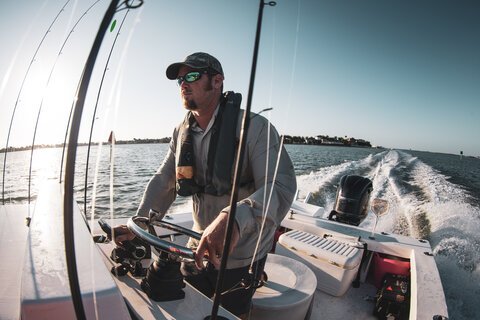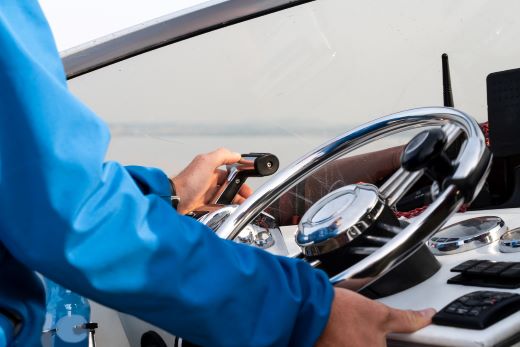Solo boating can be safe and rewarding if you know your boat well, choose calm conditions, wear a life jacket, and carry backup communication tools.
With the right solo boating tips—like filing a float plan, rehearsing docking, and practicing reboarding—you can turn boating alone into a peaceful, confidence-building experience.
Why Do People Choose Solo Boating?
Many boat owners enjoy the focus and calm that comes with boating alone. Without distractions, operating the boat becomes almost meditative—just you, the water, and the rhythm of navigation.
Solo boating also strengthens your boat handling skills. When you manage lines, fenders, docking, and decision-making yourself, confidence grows quickly. And with no crew to organize, your schedule becomes flexible. If the forecast looks great and your calendar is open, you can go.
Read Next: How to Drive a Boat
What Are the Tradeoffs of Boating Alone?
Boating alone means there's no backup if something goes wrong. If you fall overboard, injure a hand on a winch strap, or troubleshoot an engine issue in open water, you'll need to handle it yourself.
The workload also rises when you go solo sailing or boating. Launching, docking, anchoring, and maneuvering at tight marinas all fall on one set of hands. On larger boats, the effort required for lines and close-quarters handling increases. Mental fatigue can set in when you're the only lookout, navigator, and decision-maker on board.
Some tasks—like setting multiple fishing lines or managing sails in gusty winds—become more challenging when you're boating alone.
How Do You Know If Solo Boating Is Right for You?
Ask yourself a few quick questions before planning a solo boat excursion:
- Do you know your boat well?
Practice pivot turns, slow-speed handling, and backing into a slip. If your boat has a boat engine cutoff switch, wear the lanyard or use a wireless cutoff.
- Are conditions within your comfort zone?
Favor calm weather, daylight, and familiar waters. Avoid strong currents, crowded channels, and long open-water crossings while boating alone.
- Can you launch, dock, and retrieve the boat on your own?
Rehearse at a quiet ramp. Stage gear, lines, and fenders ahead of time, and double-check the winch strap and safety chain.
- Do you have a communication plan?
A charged cell phone in a waterproof case is the minimum. A handheld VHF radio and a personal locator beacon add essential layers of safety.
If these answers feel solid, a short, local solo boating trip can be a great first step.
Solo Boating Safety Checklist
When boating alone, redundancy and preparation matter. Before you leave the dock:
- Wear a Coast Guard–approved life jacket—put it on at the dock and keep it on
- Clip in the kill switch or wear a wireless fob
- Carry a charged cell phone in a waterproof pouch
- Bring a handheld VHF radio and consider a personal locator beacon
- Pack visual distress signals, a whistle or horn, and a waterproof flashlight
- Keep a throwable flotation device at the helm
- Bring paper charts or offline maps plus a power bank
- Carry a first-aid kit with bandages, medication, and waterproof tape
What Is a Float Plan and Why Use One?
A float plan is one of the simplest solo boating tips and a must when boating alone.
Share this information with a reliable contact who will notice if you don't check in:
- Boat description, registration, and color
- Launch site, route, and destinations
- Departure and return times, with a latest return time
- Your cell phone, preferred VHF channel, and emergency numbers
Text your contact before you depart and send an "all safe" message when you return.
How To Launch and Dock a Boat Solo
Preparation reduces stress at the ramp and marina:
- Load the boat, remove tie-downs, and rig fenders and lines before approaching the water
- Double-check the drain plug
- Use a long bow line you can grab from the dock after launch
- Choose quiet times of day and let faster groups go ahead
- For docking, approach at idle, shift to neutral often, and use short throttle bursts to steer
A midship line clipped to a cleat can help prevent drift while you secure bow and stern lines.
What To Do if You Fall Overboard While Boating Alone
Falling overboard solo is a scenario worth practicing:
- Wear a life jacket from the start
- Use the boat engine cutoff switch—if you leave the helm, the engine stops
- Stay with the boat; it's easier to see than a person
- Reboard using the ladder—practice this in warm, calm water
- Use the throwable device for extra flotation
- Call for help with a phone or VHF if reachable; a locator beacon can alert rescuers quickly
Rehearsal builds muscle memory, so practice self-rescue during the season.
Choosing the Right Trip When Boating Alone
Start small: short routes near shore, calm weather, and daylight. A compact center console, runabout, or small sailboat is easier to manage than a large boat with multiple systems. Know your local conditions—tides, afternoon wind, river levels, and channel traffic.
Boating on weekdays typically means less congestion, less wake, and a more relaxed trip.
When To Skip a Solo Outing
- Unsettled forecast or strong gusts
- Limited visibility
- New waterways you haven't researched
- Mechanical issues
- Offshore routes without reliable communication tools
If any of these conditions apply, go boating or sailing solo another day. It is crucial that you stay safe and avoid major problems that may arise from these conditions.
How to Enjoy Boating Alone
Boating alone should feel peaceful, not pressured. Pick a simple plan—an anchored lunch, a short nature cruise, or a quiet cove. Bring a camera, a book, or a small solo-fishing setup. Keep early outings brief, then expand your range as your comfort grows.
So, Is Solo Boating a Good Idea?
Solo boating can be safe and enjoyable when you follow these solo boating tips: know your boat, stay alert, pack proper safety gear, file a float plan, practice launching and docking, and choose calm, familiar waters. With thoughtful preparation, boating alone becomes a rewarding way to enjoy time on the water.
Solo Boating: Q&A
Q: Is it safe to go solo boating?
A: Yes—solo boating can be safe if you know your boat well, choose calm weather, wear a life jacket, and carry backup communication devices like a VHF radio or personal locator beacon. Most risks come from lack of preparation, not from boating alone.
Q: Can beginners go boating alone?
A: Beginners can go boating alone only after practicing core skills: slow-speed handling, docking, launching, anchoring, and reboarding. Start with short trips in calm, familiar waters before attempting longer outings.
Q: What should I bring when boating solo?
A: Wear a USCG-approved life jacket and use a kill-switch lanyard or wireless fob. Bring a cell phone in a waterproof case, a handheld VHF radio, visual distress signals, a first-aid kit, and a throwable flotation device. Round it out with paper charts or offline maps and a power bank so you can keep your devices charged.
Q: When should you avoid a solo boating trip?
A: Skip solo outings when there's inclement weather, poor visibility, or your boat has mechanical issues. Avoid solo boating without reliable communication tools.


